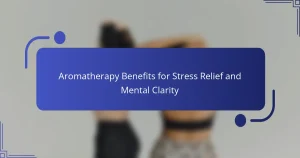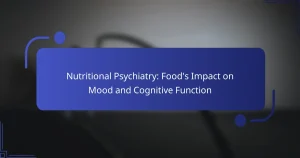Guided meditation practices provide effective anxiety relief and foster inner peace. These techniques enhance mindfulness, emotional regulation, and community support. Key methods include visualization, breath awareness, and body scans. By integrating these practices into daily routines, individuals can improve their mental resilience and overall well-being.
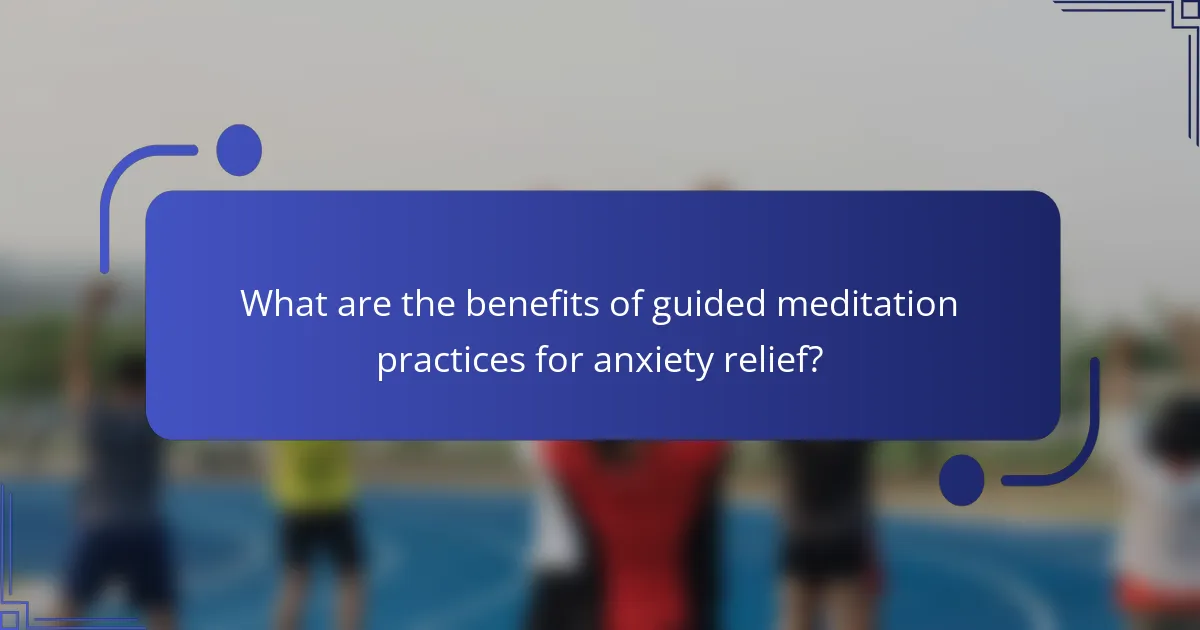
What are the benefits of guided meditation practices for anxiety relief?
Guided meditation practices significantly reduce anxiety and promote inner peace. They provide structured relaxation techniques that enhance mindfulness and emotional regulation.
Research indicates that regular guided meditation can lower cortisol levels, leading to reduced stress. Participants often report improved focus and a greater sense of calm. Furthermore, these practices can foster a supportive community, enhancing social connections and emotional support.
Incorporating visualizations and calming narratives, guided meditations help individuals confront and process anxiety triggers. This approach often leads to long-term coping strategies and improved mental resilience.
Overall, guided meditation serves as a powerful tool for managing anxiety, offering both immediate relief and lasting benefits for emotional well-being.
How does guided meditation help reduce anxiety symptoms?
Guided meditation significantly reduces anxiety symptoms by promoting relaxation and mindfulness. It encourages individuals to focus on their breath and present moment, which helps to calm racing thoughts. Research indicates that regular practice can lower cortisol levels, the stress hormone, leading to improved emotional regulation. Additionally, guided meditation fosters a sense of inner peace, enhancing overall mental well-being. By incorporating visualization techniques, it also allows individuals to create a mental safe space, further alleviating anxiety.
Which mental health benefits are associated with regular guided meditation?
Regular guided meditation enhances mental health by reducing anxiety, improving emotional regulation, and fostering inner peace. Participants often experience decreased stress levels and increased mindfulness. Research indicates that consistent practice can lead to a 30% reduction in anxiety symptoms. Additionally, guided meditation promotes self-awareness and enhances overall well-being, making it a valuable tool for mental health improvement.
Why is inner peace an important aspect of anxiety management?
Inner peace is crucial for managing anxiety as it promotes emotional stability and resilience. Achieving inner peace through guided meditation can reduce stress levels, enhance self-awareness, and improve overall mental health. Studies show that regular meditation practice can lower anxiety symptoms by up to 60%. This practice fosters a calm state of mind, allowing individuals to respond to stressors more effectively. By integrating guided meditation into anxiety management strategies, individuals can cultivate a sustainable sense of inner peace, leading to long-term emotional well-being.
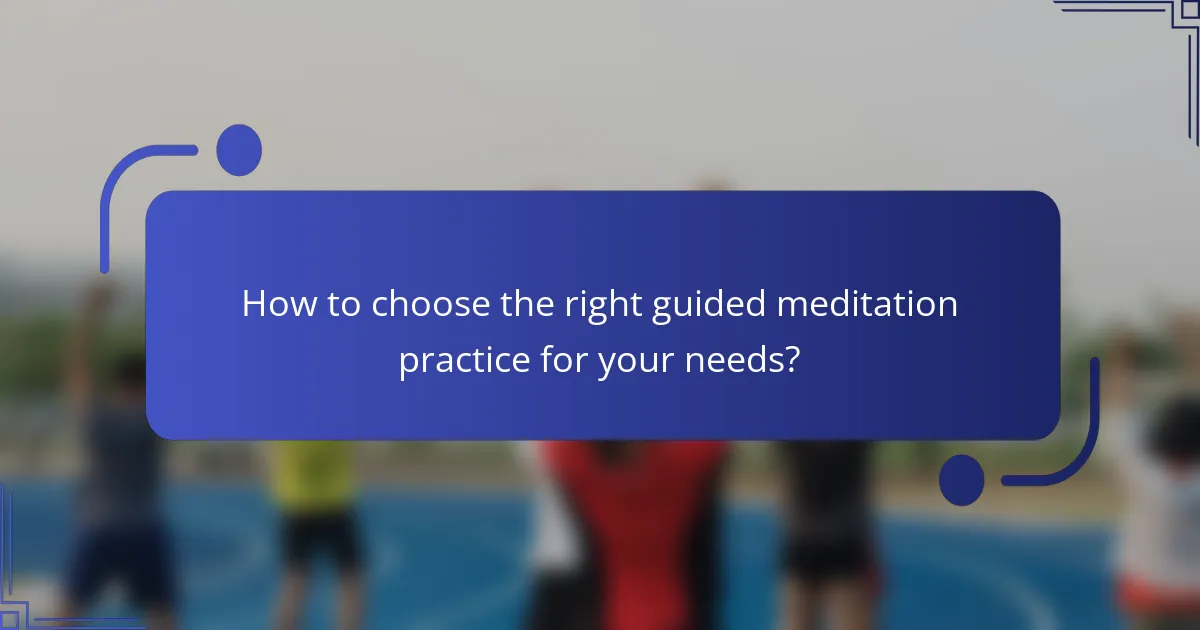
How to choose the right guided meditation practice for your needs?
To choose the right guided meditation practice for anxiety relief and inner peace, assess your specific needs and preferences. Start by identifying the type of anxiety you experience, as some meditations focus on relaxation while others enhance mindfulness.
Consider the duration of practice that fits your schedule; shorter sessions may be more manageable for beginners. Explore different styles, such as body scan, loving-kindness, or breath awareness, as each offers unique benefits.
Evaluate the format that suits you best, whether audio, video, or in-person sessions. Look for practices that resonate with your values and beliefs, as this alignment can enhance effectiveness.
Finally, seek recommendations or reviews to find credible sources and experienced guides. By aligning these factors, you can select a guided meditation practice that effectively supports your journey toward anxiety relief and inner peace.
What factors should you consider when selecting a guided meditation?
When selecting a guided meditation, consider the style, duration, and voice of the guide. Choose a style that resonates with you, whether it’s mindfulness, visualization, or body scan. The duration should fit your schedule, ranging from a few minutes to an hour. Additionally, the voice of the guide can significantly impact your experience; select someone whose tone and pace are calming to you.
Which formats of guided meditation are most effective for anxiety relief?
Guided meditations that focus on mindfulness, body scan, and loving-kindness are most effective for anxiety relief. These formats promote relaxation and emotional regulation, helping individuals manage anxiety symptoms. Mindfulness meditation encourages present-moment awareness, body scan meditation enhances bodily awareness, and loving-kindness meditation fosters compassion towards oneself and others. Each format can be tailored to individual preferences, increasing their effectiveness in reducing anxiety.
How do cultural influences shape guided meditation practices?
Cultural influences significantly shape guided meditation practices by integrating traditional beliefs and values. Different cultures emphasize various techniques, such as visualization or mantra repetition, to address anxiety and promote inner peace.
For instance, Buddhist traditions often incorporate mindfulness and breath awareness, while Western practices may focus on relaxation and stress reduction techniques. These cultural nuances affect the structure and intent of meditation sessions, tailoring them to specific audience needs.
Moreover, the incorporation of music, nature sounds, or spoken guidance varies across cultures, enhancing the overall experience. This diversity allows practitioners to choose methods that resonate with their personal beliefs, fostering a deeper connection to the practice.
In summary, cultural backgrounds influence the effectiveness and appeal of guided meditation, enriching the journey towards anxiety relief and inner peace.
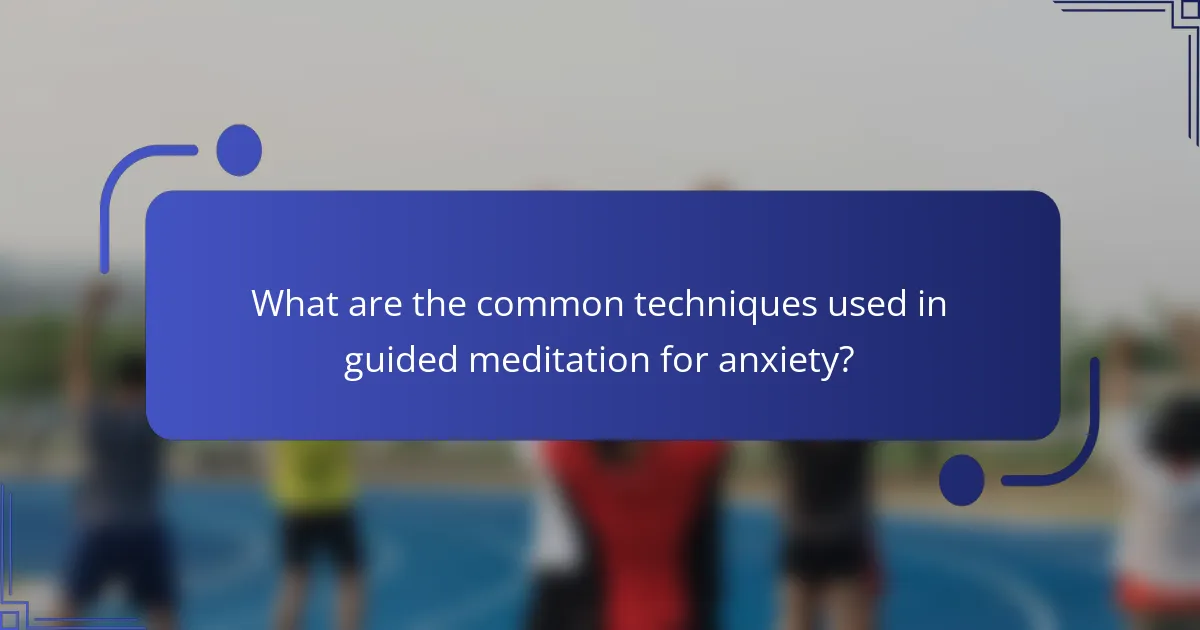
What are the common techniques used in guided meditation for anxiety?
Common techniques used in guided meditation for anxiety include visualization, breath awareness, body scan, and affirmations. These practices help calm the mind and promote relaxation.
Visualization guides individuals to imagine peaceful scenarios, reducing stress. Breath awareness focuses on deep, mindful breathing to anchor attention and alleviate anxiety. The body scan technique encourages awareness of physical sensations, fostering relaxation throughout the body. Affirmations involve repeating positive statements, enhancing self-confidence and emotional resilience.
These techniques collectively support anxiety relief and contribute to overall inner peace.
How do visualization and imagery enhance guided meditation experiences?
Visualization and imagery significantly enhance guided meditation experiences by deepening relaxation and focus. These techniques create vivid mental scenes that engage the mind, allowing individuals to immerse themselves fully in the practice. As a result, participants often experience reduced anxiety and heightened inner peace.
Imagery can evoke positive emotions, reinforcing the calming effects of meditation. For example, visualizing a serene landscape may trigger feelings of tranquility, promoting a sense of safety and comfort. This emotional engagement can lead to more effective stress relief.
Moreover, visualization serves as a tool for intention setting during meditation. By picturing desired outcomes, such as emotional balance or clarity, practitioners align their focus with their goals. This unique attribute of guided meditation fosters a proactive mindset, enhancing overall effectiveness.
Incorporating imagery into meditation practices can also cater to individual preferences. Some may resonate with nature scenes, while others might prefer abstract concepts. This adaptability makes guided meditation a versatile approach to achieving anxiety relief and inner peace.
What role does breathwork play in guided meditation for anxiety relief?
Breathwork is essential in guided meditation for anxiety relief as it promotes relaxation and mindfulness. Controlled breathing techniques help regulate the nervous system, reducing stress and enhancing emotional stability. This practice allows individuals to focus on their breath, fostering a deeper connection to the present moment. As a result, practitioners often experience a reduction in anxiety symptoms and an increase in overall well-being.
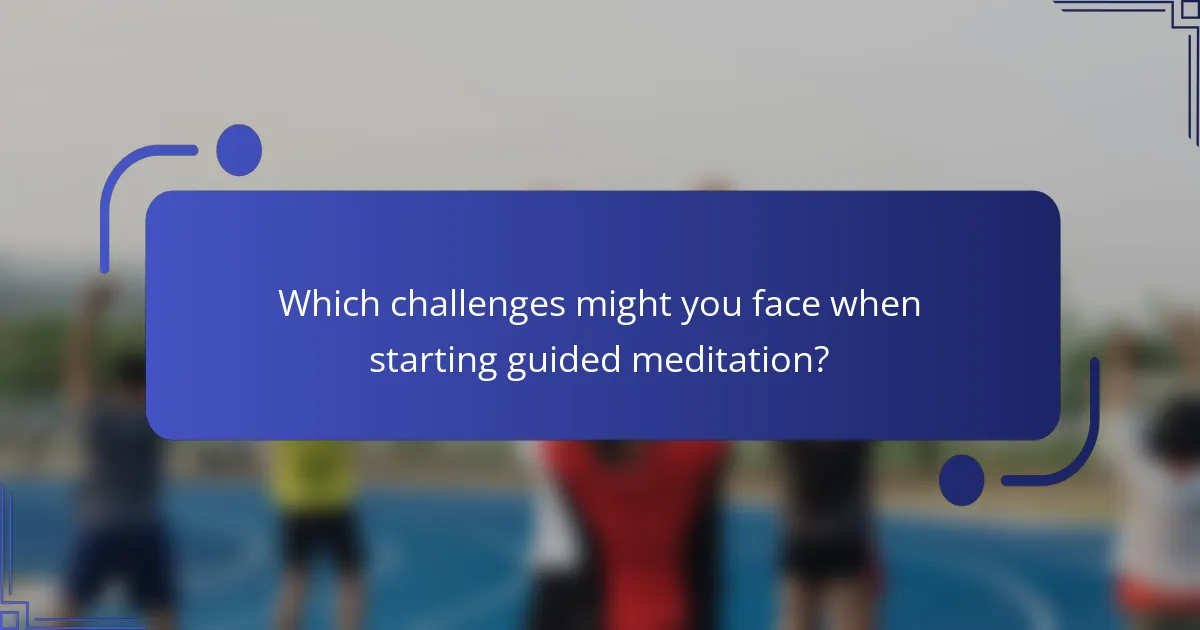
Which challenges might you face when starting guided meditation?
Starting guided meditation may present challenges such as difficulty in maintaining focus, managing expectations, and finding the right resources. Beginners often struggle with distractions, which can hinder the experience. Setting realistic goals is essential to avoid frustration. Additionally, selecting a suitable guided meditation format can be overwhelming due to the variety available.
How can distractions impact your guided meditation sessions?
Distractions can significantly hinder the effectiveness of guided meditation sessions. They disrupt focus, making it challenging to achieve the desired state of relaxation and mindfulness. Common distractions include noise, interruptions, and wandering thoughts.
Managing these distractions is crucial for maximizing the benefits of meditation. Creating a quiet, dedicated space enhances concentration. Additionally, setting a specific time for practice can help establish a routine, reducing the likelihood of interruptions.
Practicing mindfulness techniques can also improve focus during sessions. Techniques such as deep breathing or body scanning can help redirect attention back to the meditation. As a result, individuals may experience greater anxiety relief and a deeper sense of inner peace.
What strategies can help overcome common obstacles in meditation practice?
Establishing a consistent routine, utilizing guided meditations, and creating a conducive environment can help overcome obstacles in meditation practice. Regular scheduling builds habit, while guided sessions provide structure and focus. A quiet, comfortable space minimizes distractions, enhancing the overall experience.
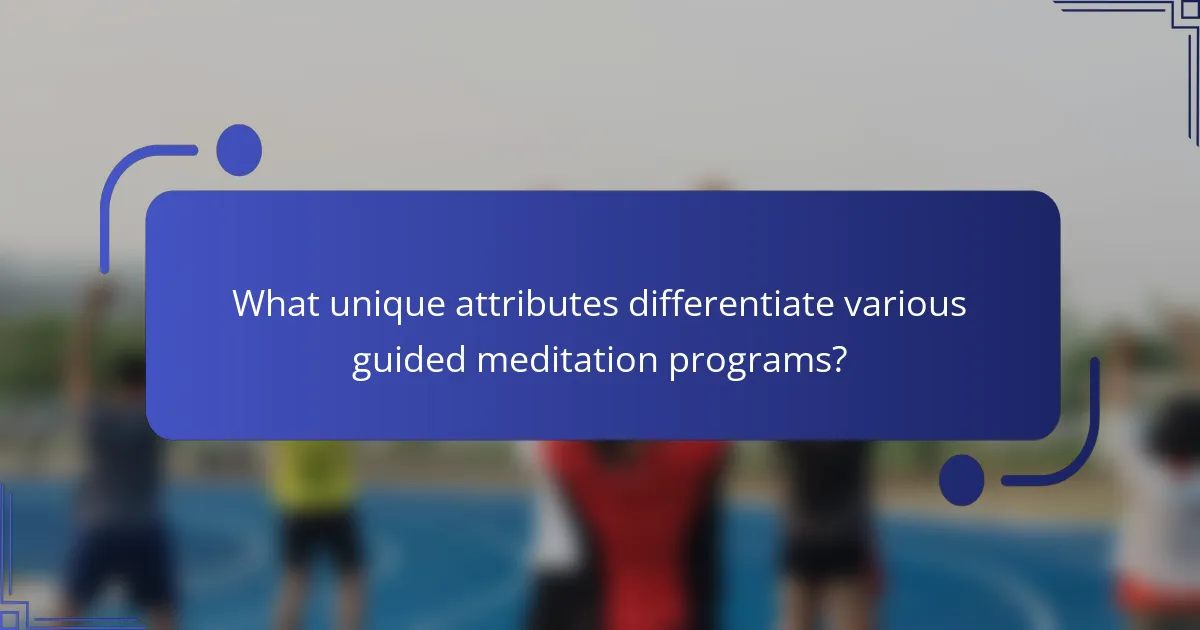
What unique attributes differentiate various guided meditation programs?
Various guided meditation programs differ mainly in their techniques, duration, and focus areas. Unique attributes include the incorporation of specific themes, such as nature sounds or visualization, and the qualifications of the instructors. Some programs may offer personalized sessions, while others follow a set curriculum. Additionally, rare attributes like the use of biofeedback technology or integration with yoga practices can further differentiate them.
How do personalized guided meditations cater to individual anxiety triggers?
Personalized guided meditations effectively address individual anxiety triggers by tailoring techniques to specific emotional responses. These meditations incorporate unique attributes such as voice selection, background sounds, and personalized scripts that resonate with the individual’s experiences. For example, someone with social anxiety may benefit from scenarios that reduce feelings of isolation, while another person may need strategies to cope with work-related stress. As a result, users often report heightened relaxation and improved coping mechanisms. This customization enhances the overall effectiveness of meditation practices for anxiety relief and inner peace.
Which platforms offer specialized guided meditation for specific demographics?
Several platforms offer specialized guided meditation tailored for specific demographics. Headspace provides content for children and teens, while Insight Timer focuses on diverse groups, including veterans and those dealing with grief. Calm features programs for workplace stress and anxiety relief. 10% Happier targets skeptics and beginners. Additionally, Simple Habit offers sessions designed for busy professionals. Each platform addresses unique needs, enhancing the meditation experience for various audiences.
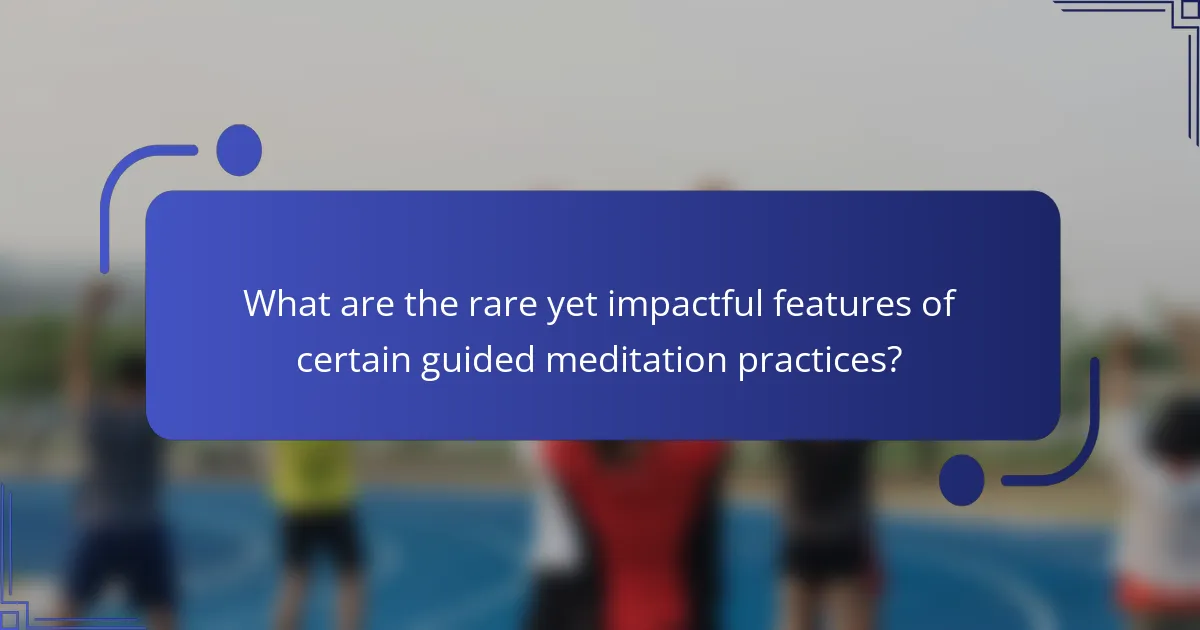
What are the rare yet impactful features of certain guided meditation practices?
Certain guided meditation practices possess rare yet impactful features that enhance anxiety relief and promote inner peace. These features include personalized visualization techniques, which tailor the meditation experience to individual needs, and the integration of biofeedback, allowing practitioners to monitor physiological responses during sessions. Another unique aspect is the incorporation of sound healing elements, such as specific frequencies, which can deepen relaxation and emotional release. Additionally, some practices utilize nature immersion, where meditations are conducted outdoors, fostering a profound connection with the environment. Lastly, the use of storytelling in guided sessions can create a powerful narrative that resonates on a personal level, facilitating deeper introspection and healing.
How do live guided sessions compare to pre-recorded ones in effectiveness?
Live guided sessions are generally more effective than pre-recorded ones for anxiety relief and inner peace. They provide real-time interaction, fostering a sense of community and accountability. Participants can ask questions and receive immediate feedback, enhancing their experience.
Pre-recorded sessions offer convenience and flexibility, allowing users to practice at their own pace. However, they lack the personal touch and adaptability of live sessions. A study found that 70% of participants preferred live sessions for their dynamic engagement.
In summary, while both formats have their benefits, live guided sessions often lead to deeper connections and more effective outcomes in guided meditation practices.
What advanced techniques can enhance the guided meditation experience?
Incorporating advanced techniques can significantly enhance the guided meditation experience. Techniques such as visualization, soundscapes, and breath control deepen relaxation and focus.
Visualization involves creating mental images to evoke tranquility, enhancing emotional release. Soundscapes, including nature sounds or binaural beats, can elevate the meditative state and promote a sense of presence. Breath control techniques, such as diaphragmatic breathing, help regulate stress responses and increase mindfulness.
Combining these methods can lead to profound anxiety relief and inner peace, creating a more immersive guided meditation experience.
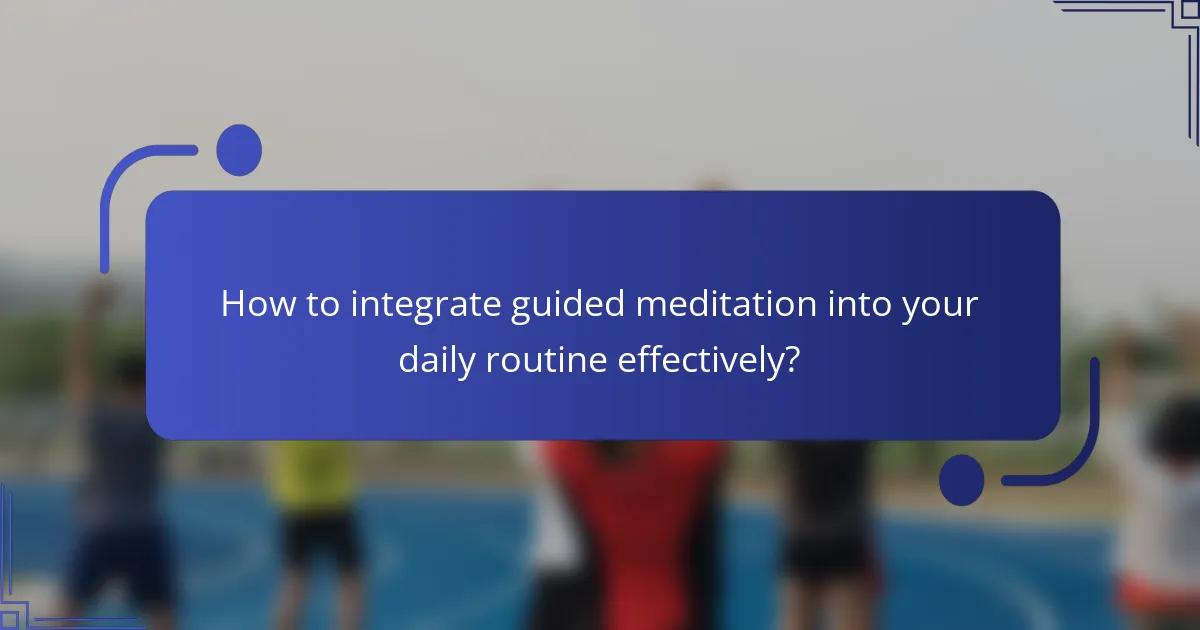
How to integrate guided meditation into your daily routine effectively?
Integrating guided meditation into your daily routine can enhance anxiety relief and promote inner peace. Start by dedicating a specific time each day, such as morning or evening, to practice.
1. Choose a quiet space free from distractions.
2. Select a guided meditation that resonates with your needs, focusing on anxiety relief or relaxation.
3. Use a timer to maintain a consistent duration, ideally 10-20 minutes.
4. Incorporate mindfulness techniques, like deep breathing, during the practice.
5. Reflect on your experience afterward to deepen your understanding and connection.
As a result, this structured approach helps establish a lasting meditation habit, enhancing overall mental well-being.
What are best practices for maintaining consistency in your meditation practice?
To maintain consistency in your meditation practice, establish a regular schedule, create a dedicated space, and utilize guided sessions. Consistency builds familiarity and enhances the benefits of meditation for anxiety relief and inner peace.
Start by setting a specific time each day for your practice, even if it’s just a few minutes. Next, designate a quiet area free from distractions to help you focus. Finally, consider using guided meditations tailored for anxiety relief, as they provide structure and support, making it easier to stay committed.
Which tips can optimize the benefits of guided meditation for anxiety relief?
To optimize the benefits of guided meditation for anxiety relief, establish a consistent practice schedule. Focus on your breath and stay present during sessions. Use visualization techniques to enhance relaxation. Incorporate mindfulness principles to deepen awareness. Experiment with different meditation styles to find what resonates best.

